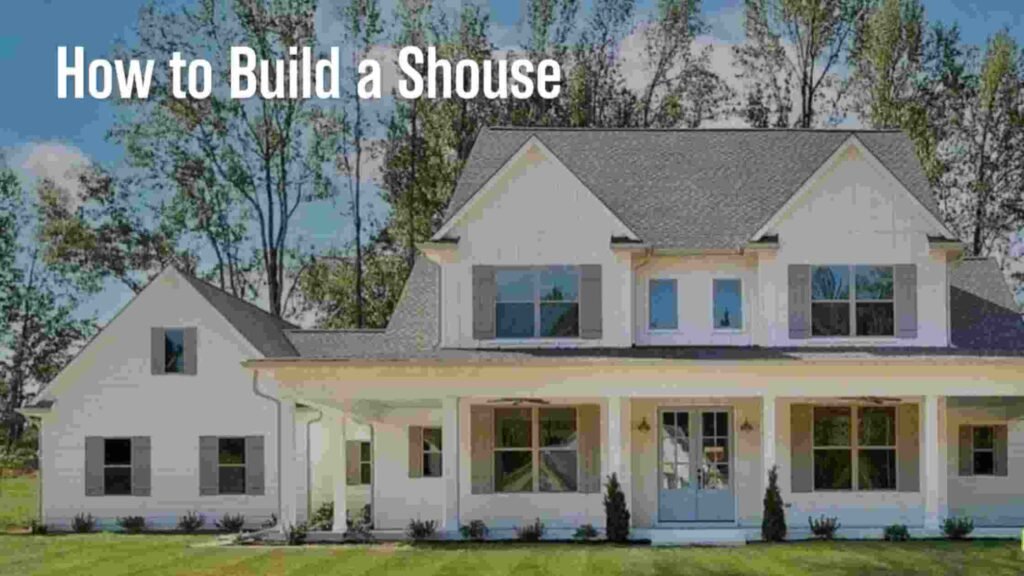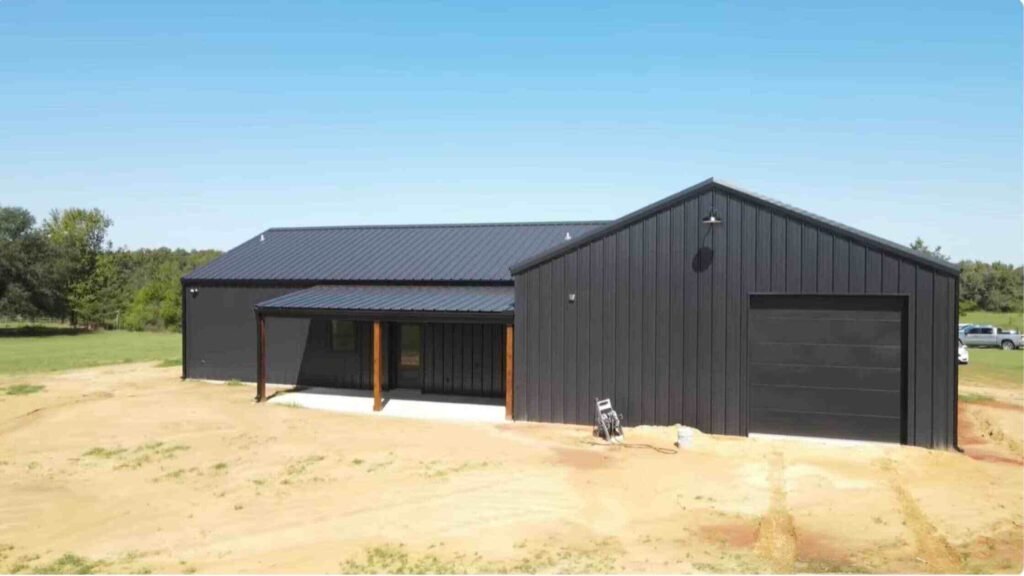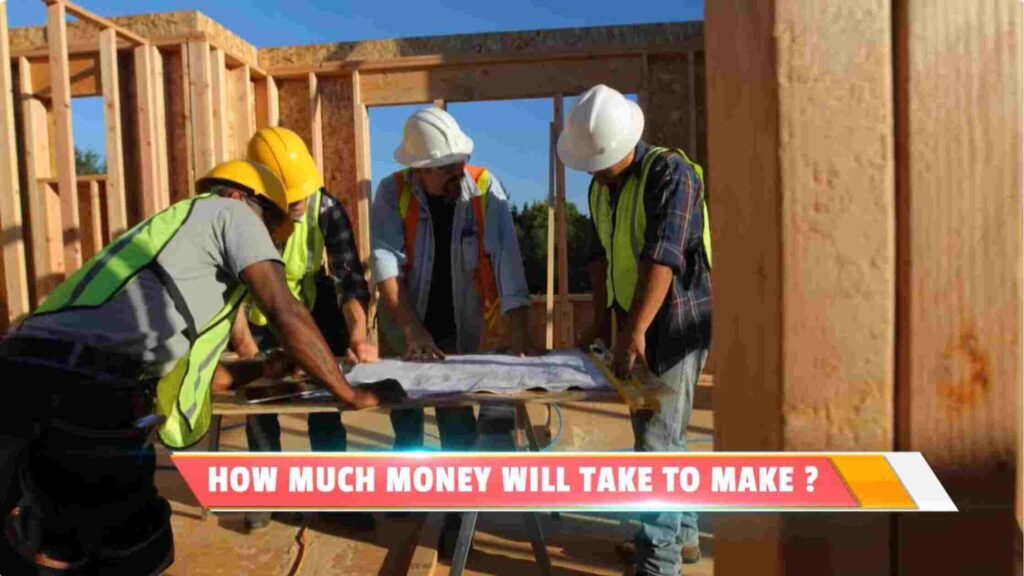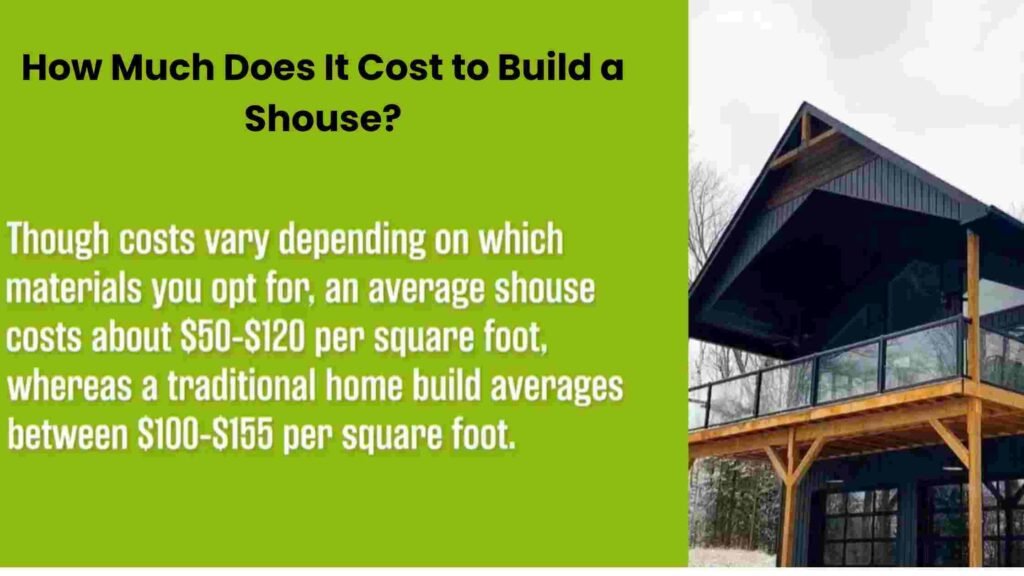Cost to Build a Shouse typically costs between $100 to $200 per square foot. The price varies based on location, materials, and customizations.
Constructing a Shouse—a combination of a shop and a house—presents a unique and cost-effective solution for those seeking a multipurpose living space. This hybrid structure has gained popularity amongst homeowners who desire the functionality of a workshop or garage coupled with the comfort of residential living quarters.
Often, these buildings feature high ceilings, ample storage, and customizable floor plans that cater to both personal and professional needs. The cost efficiency stems from the Shouse’s simplistic design, which allows for a more streamlined construction process compared to traditional homes. While the upfront investment may be considerable, the long-term savings in utility and maintenance costs can be significant, providing both a practical and economically smart choice for savvy homebuilders.
Defining The Shouse Concept

A Shouse combines a workshop and a house. This unique blend creates a multi-purpose structure that is gaining popularity. People use Shouses for living, working, or both. They offer a practical solution for those needing a custom space. Let’s explore what makes a Shouse and how it stands out.
The Shouse Aesthetic
The aesthetic of a Shouse strikes a balance between rustic and modern. Its exterior often features metal siding, reminiscent of a barn or warehouse. Inside, the Shouse can be as cozy or as industrial as the owner prefers. Large, open spaces are a hallmark. They allow for plenty of room to move about. Natural light often pours in through generous windows and skylights. This creates an inviting and adaptable environment.
Functional Aspects Of A Shouse
Functionality is at the heart of a Shouse’s design. The design allows for various uses within the same structure. Here are key functional aspects:
- Combined Living And Working Areas: An efficient use of space for residents and their businesses.
- Versatile Floor Plans: Owners can customize layouts to their specific needs.
- Durable Materials: Shouses often use steel frames and metal siding for longevity.
- Energy Efficiency: Insulation and design aim to reduce energy costs.
A Shouse is an appealing option for its aesthetic and functionality. Its cost will vary based on size, materials, and location. Understanding the Shouse concept is the first step in estimating the potential cost of building one.
Cost Variables For Shouse Construction
When planning to build a Shouse (shed + house), the final price tag can vary greatly. A multitude of cost variables play significant roles in shaping the overall budget. Understanding these variables ensures an informed decision-making process for potential Shouse owners.
Size And Complexity Impact
Size matters when estimating construction costs. Larger square footage translates to higher expenses. Complexity adds another layer. Simple designs can save money. Detailed customizations lead to increased costs. Here’s how these factors might affect your budget:
- Basic layouts are more budget-friendly.
- Multi-level designs drive up the cost.
- Additions like garages or porches are extra.
Material Choices And Their Impact On Cost
Material selection is critical. Quality and type influence the final cost significantly. Here’s a quick glance at how different materials can impact your Shouse budget:
| Material | Cost Impact |
|---|---|
| Steel Framing | Durable but pricier |
| Wood Framing | More affordable, less durable |
| Luxury Finishes | Upscale but costly |
Cheaper materials reduce upfront costs. Remember, they might lead to higher maintenance costs. Investing in quality pays off in the long term.
Site Preparation And Land Costs

Creating a shouse (shop + house) begins with two critical steps: buying land and preparing it for construction. Understanding the costs associated with these stages ensures a solid foundation for your dream shouse. Let’s delve into the details of land assessment and plot preparation expenses.
Assessing The Price Of Land
The search for the perfect spot for a shouse starts with knowing land prices. The cost varies widely based on factors like:
- Location: Urban areas generally command higher prices than rural settings.
- Size: More acreage typically means a higher price tag.
- Zoning: Land intended for residential use might have different costs compared to commercial zones.
Research is key. Look at recent sales in your chosen area to get a baseline cost. Websites like Zillow or local county records can help.
Gauge utility access, which can add to initial costs. Areas without electricity, water, or sewer services will require extra work.
| Utility | Additional Cost Implication |
|---|---|
| Electricity | Cost depends on distance from the grid |
| Water | Drilling a well or connecting to city water |
| Sewer | Septic system or connection fees |
Preparing The Plot For Construction
With the land secured, the next step is getting it build-ready. Site preparation involves:
- Clearing: Removal of trees, brush, and debris.
- Grading: Leveling the land for a stable base.
- Access: Creating roads or driveways.
The terrain affects costs greatly. Flat, clear land is cheaper to prepare than wooded or hilly plots. Contracting professionals for a site survey and clearance can offer exact cost figures.
Do not forget permits, as these are necessary for construction and can have varied costs depending on local regulations.
Breaking down these costs early helps with budgeting for the entire shouse project. Align the land choice with your budget, and account for every detail in plot preparation to pave the way for a successful build.
Design And Architectural Planning Fees

Planning your dream shouse— a blend of shed and house — involves exciting design choices and important financial decisions. One vital aspect to consider is the cost for design and architectural planning. These fees can vary greatly depending on the complexity and customization of your project.
Hiring An Architect: Is It Worth It?
Investing in an architect might seem expensive at first. Experts bring your vision to life safely and efficiently. Look at the benefits:
- Professional Expertise: Architects turn your ideas into detailed plans.
- Permit and Zoning Help: They navigate legal requirements with ease.
- Cost Savings: Smart designs often reduce construction costs.
Remember, the architect’s fee, typically a percentage of the overall cost, ensures your shouse is both practical and aesthetically pleasing.
Ready-made Vs. Custom Designs
Choosing between ready-made and custom designs impacts your budget.
| Ready-Made Designs | Custom Designs |
|---|---|
| More Affordable Faster Turnaround Limited Modifications | Higher Cost Personalized Unlimited Flexibility |
Select ready-made designs to save money and time. Choose custom plans for a unique shouse that fits your specific needs.
The Price Of Permits And Legalities
Building a shouse, a combination of a shed and a house, involves more than just picking out designs and materials. The price of permits and legalities can significantly affect your overall budget. Before laying the first brick, understanding these costs is crucial. Permits ensure your shouse meets local safety standards.
Navigating Zoning And Building Codes
Zoning laws and building codes might seem daunting. You need to know what your local government allows. Zoning laws dictate where you can build a shouse. They look at land use, property lines, and building size. Building codes focus on safety. They cover construction standards, electrical systems, and plumbing.
To navigate these, check your city or county’s planning department website. You can also visit in person. They provide maps and code books. Sometimes, an expert’s advice may be needed. Contractors or architects in your area will know these codes.
Permit Costs: A Necessary Investment
You might wonder, “What will permits cost me?” Prices vary based on location, size, and project type. A simple table can help you understand the costs:
| Permit Type | Cost Range |
|---|---|
| Building | $400 – $2,000 |
| Electrical | $50 – $500 |
| Plumbing | $50 – $500 |
| HVAC | $250 – $400 |
Remember, these are just ranges. Your actual costs could be more or less. Contact your local authorities for exact figures. You will pay these fees when you submit your permit applications.
Always include permit costs in your budget. It’s better to plan than face surprises later.
Permit costs are an investment in your shouse’s safety and legality. Paying these fees avoids fines and delays in your building process.
Foundation And Structure Costs
Planning a shouse, or shed house, merges the convenience of a workshop with the comfort of a home. Costs might worry you. Knowing what to expect can ease that worry. This post focuses on the two main expense areas: foundations and structures.
The Expense Of A Solid Foundation
A stable foundation ensures your shouse stands the test of time. Not all land is the same, and neither are foundation costs. Prices depend on size, materials, and soil type. The table below shows the average costs you might expect:
| Type of Foundation | Average Cost |
|---|---|
| Concrete Slab | $4-$8 per square foot |
| Crawl Space | $7-$14 per square foot |
| Basement | $10-$25 per square foot |
Prices vary based on location and market.
Structural Costs: Frame To Finish
Framing gives your shouse shape and strength. After the foundation, the frame is next. It includes walls, roofs, and floors. Here’s a list of common materials and their cost ranges:
- Wood frame: $5-$15 per square foot
- Steel frame: $3-$10 per square foot
- Roofing: $3-$7 per square foot
Coverage for doors, windows, and insulation comes after the frame:
- Exterior doors: $500-$2,000 each
- Windows: $200-$1,200 each
- Insulation: $0.50-$2.00 per square foot
Interior Finishing And Aesthetics
Interior finishing and aesthetics play a crucial role in transforming your shouse from a basic structure into a home you love. Deciding on the materials and styles that fit your vision while keeping costs under control can be a balancing act. Below, we dive into strategies for selecting interior elements that both meet your design aspirations and align with your budget.
Choosing Cost-effective Interior Materials
Mindful material selection is key to cost-effective interior finishing. Here’s how to stretch your dollar:
- Opt for laminate over hardwood flooring for a similar aesthetic at a fraction of the cost.
- Consider painted MDF (medium-density fiberboard) for stylish and affordable trim work.
- Use ceramic tiles that mimic stone to deliver elegance without the high price tag.
- Select quartz countertops, which are less expensive than granite but deliver a premium look.
Balancing Style And Budget
Here are ways to strike a perfect balance:
| Style Aspect | Cost-Friendly Options |
|---|---|
| Lighting | Choose LED fixtures that are stylish yet energy-saving. |
| Cabinetry | Select stock models and personalize them with unique hardware. |
| Wall Finishes | Use a combination of paint and feature wallpaper for impact. |
| Flooring | Invest in high-traffic areas with better materials, and economize on others. |
Utilities And Services Installation
The journey to your dream shouse doesn’t stop at construction. Installing utilities and services is vital. It brings comfort and convenience into your new space. Let’s dive into the costs involved with utilities and the steps for installation.
Understanding The Costs Of Utilities
Knowing how much you’ll pay for utilities is key. These include water, electricity, gas, and sewage. Costs vary by location and usage. Here’s a breakdown:
- Water: Hookup fees, plus usage rates.
- Electricity: Installation charges, ongoing monthly bills.
- Gas: If required, consider meter and connection costs.
- Sewage: Septic system or public sewer fees apply.
Remember to also budget for permits and inspections. These are a part of the overall cost.
Contracting Services For Installation
Professionals are needed to install utilities safely. Selecting the right contractor is crucial. Be sure to:
- Research local service providers.
- Get multiple quotes to compare pricing.
- Check reviews and verify licenses.
- Discuss timelines to align with your shouse completion date.
Here’s a glimpse of what services may cost:
| Service | Average Cost |
|---|---|
| Water Hookup | $1,500-$5,000 |
| Electrical Service | $3,500-$8,000 |
| Gas Installation | $500-$2,000 |
| Sewer Connection | $1,500-$15,000 |
Review the quotes carefully. Boldly ask questions. Ensure you understand what’s included. A clear agreement avoids unexpected costs later on.
Exterior Amenities And Landscaping
The Exterior Amenities and Landscaping of a shouse (shed + house) blend aesthetics with functionality. Both elements play a vital role in the overall cost and enjoyment of your property. Let’s explore how to enhance the outside of your home without breaking the bank.
Creating Curb Appeal On A Budget
Curb appeal matters, and you don’t need deep pockets to make a big impact. Here are cost-effective strategies:
- Paint: A fresh coat on the exterior or front door offers instant charm.
- Plantings: Flower beds and shrubs add life and color affordably.
- Lighting: Solar-powered lights illuminate paths without added electricity costs.
DIY projects like repurposed planters or homemade signs also contribute to curb appeal, keeping expenses minimal.
The Cost Of Outdoor Living Spaces
An inviting outdoor space is a prized feature. Here’s an overview of potential costs:
| Feature | Basic | Premium |
|---|---|---|
| Patio/Deck | $5 per sq ft | $30 per sq ft |
| Outdoor Kitchen | $3,000 | $15,000+ |
| Fire Pit | $200 | $1,500+ |
Remember, choices like materials and design define the final cost. Use this table to budget for your outdoor retreat.
Final Thoughts On Shouse Budgeting
When budgeting for a shouse (shed plus house), it’s vital to plan with precision. Proper budgeting ensures this unique living space meets all your needs without breaking the bank. Let’s conclude our shouse cost breakdown with some key pointers to guide your financial planning.
Keeping Costs Under Control
Selecting materials wisely and doing some work yourself can trim expenses. Here’s how to keep your house-building costs in check:
- Choose cost-effective materials: Opt for items that offer durability and value.
- Consider DIY: Tackle tasks like painting to reduce labor costs.
- Plan your design: Simple layouts often cost less to build.
- Get multiple quotes: Compare prices from various contractors and suppliers.
Anticipating Unexpected Expenses
Unexpected costs can surface. Being financially prepared is crucial. Remember these points:
- Set aside a contingency fund: Aim for 10-15% of your total budget.
- Plan for overages: Costs can overshoot estimates, so plan accordingly.
- Factor in permits and fees: Identify all necessary costs beyond construction.
- Inspect land: Prior land assessment can prevent costly surprises.
Frequently Asked Questions How Much Does It Cost to Build a Shouse?
Is Building A Shouse Cheaper Than A House?
Building a shouse can often be less expensive than constructing a traditional house due to simplified design and material costs.
What Does An Average Shouse Cost?
An average Shouse (shop + house) typically costs between $100 to $200 per square foot. Prices may vary based on location, materials, and customizations.
What Is The Average Size Of A Shouse?
The average size of a shouse (shop + house) typically ranges from 1,800 to 2,400 square feet.
What’s The Difference Between A Barndominium And A Shouse?
Barndominiums combine barn and condominium features, often showcasing a steel frame, while shouses blend shop space with traditional house elements, usually incorporating a workshop or garage area.
Conclusion
Understanding the cost of constructing a shouse is vital for budget planning. The price varies, depending on size, materials, and location. Remember, an efficient design can help save on costs. For tailored advice, consulting with professionals is recommended. Begin your build journey with a clear financial plan.


